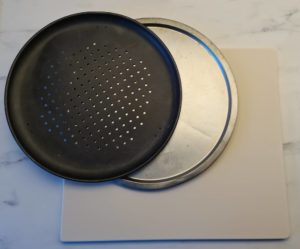Pizza stones come in a variety of different materials. They all have their pros and cons, but this guide will try to answer what the best pizza stone material is.
Are All Pizza Stones the Same?
Not all pizza stones are the same. Different materials have different properties that can affect pizza baking time, how crispy the pizza gets, and how simply how long the stone will hold up. Two of the most important considerations are pizza baking speed and the durability of the pizza stone.
Baking Speed and Crispiness
Baking speed is something many people neglect when they choose a pizza stone. If your oven can’t hold up with the baking speed of your stone, you may end up with a crispy pizza, but unmelted cheese on the top of your pizza. Or, the pizza stone may not conduct enough heat, making your toppings burn before the bottom of the pizza is done.
What determines the baking speed is mainly the conductivity of the material. This is how efficiently or fast the material transfers heat. The higher the conductivity, the faster the pizza will bake.
The main factors of conductivity are the material the stone is made of, and the thickness of the stone.
In short, a thicker stone will retain more heat allowing it to bake pizza faster and bake multiple pizzas right after each other. A thinner stone can’t hold as much heat. This means the baking time slows down, and when you bake several consecutive pizzas without reheating the stone, it will cool down and make each pizza less and less crispy. We have an article about pizza stone thickness, and how it affects baking times if you’re interested in the topic.
But the material of the stone also has a big impact on the baking time. Different materials conduct heat differently, meaning you’ll need a thicker or thinner stone to achieve the same baking times, depending on the material. Steel, for example, retains and conducts heat much better than clay and doesn’t need to be as thick as a clay stone.
When it comes to crispiness, the temperature, conductivity, and the material’s ability to absorb moisture affect the result. A pizza gets crispy when enough water has vaporized, so material that absorbs moisture better will quickly make the pizza crispy.
Cleaning
Not all materials are the same when it comes to cleaning either. A smoother surface will make it easier to get rid of food soils and fat that has spilled on the stone during baking. But some materials also absorb moisture and fat more. This might be a benefit when it comes to crisping up the pizza, but for cleaning it’s not. Fat that’s absorbed by the pizza stone is almost impossible to get rid of. It may also start giving off unpleasant odours during baking, which in the worst case may flavor your pizza.
Cracking
Cracking is probably the number one reason why a pizza stone needs to be replaced. Pizza stones, especially made from ceramic materials, are prone to cracking due to thermal shock. This means that a huge temperature difference in a short amount of time makes the material crack. For some materials, this is a huge problem, while for others it’s not something you need to be concerned about at all.
I’ve personally been through a bunch of pizza stones made from different materials and experienced how easily some of them can break. If you want to know more about cracking and how to prevent it, check out this article.
This article will try to give you an overview of different pizza stone materials, give you the pros and cons, and help you decide what the best pizza stone is for your particular use.
Ceramic
Ceramics is a category of materials that are shaped and hardened with heating. It’s probably the most common pizza stone material, that can be found in most kitchen stores. It’s a cheap material that crisps the pizza with a combination of transferring heat and absorbing moisture from the pizza crust.
Ceramic is actually a heat-resistant material. It’s therefore a great choice for a hot oven to control the temperature. It is however less ideal for a baking surface for a home oven. Since you want the material to conduct as much heat as possible to bake pizza faster and hotter. But retains heat well, meaning it holds onto the heat well. It will therefore bake pizza way better than a baking tray.
It is however a brittle material, which means it is prone to cracking due to thermal shock. You, therefore, have to be careful when heating and cooling the stone to prevent cracking.
Another disadvantage of ceramic pizza stones is that they are hard to clean. The reason is that most ceramic stones come with a rough surface. In addition to that, they absorb oils easily. This makes it hard to get rid of the oil. These oils can also make bad odors, that may affect the flavor of your pizza.
Clay
Clay is a type of ceramic used for pizza stones. It’s made from fine-grained natural soil material with the addition of water. The clay is then heated at a high temperature to create a hard baking surface.
Clay is one of the cheapest pizza stone materials, and can often be found for 20 dollars or less. It’s therefore affordable if you want to explore baking pizza on a pizza stone.
It’s a porous material, which means it contains pores (voids), and cracks easily. This is a huge disadvantage of clay pizza stones. You, therefore, have to be extra careful when dealing with clay. And avoid huge, rapid changes in temperature.
Clay is similar to other types of ceramic stones hard to clean. The pores absorb oil, which is very hard to get rid of.
Cordierite
Cordierite is a mineral that occurs as crystals, that are added to ceramic to make it stronger.
It’s a stronger, more durable material than regular ceramic and clay. And is less prone to cracking. The reason is that cordierite has a low thermal expansion, meaning that it expends less when exposed to changes in temperature. It’s therefore not as prone due to cracking due to thermal shock.
When it comes to conductivity and the ability to retain heat, cordierite is similar to other ceramic pizza stones.
Pizza stones made from cordierite are typically a little bit more expensive than clay and other types of ceramic. But they will last longer, so it’s not necessarily a bad investment!
Like ceramic, pizza tones made from cordierite tend to be harder to clean.
Cast Iron
Another baking pizza baking material is cast iron. Pizza stones made from cast iron are pretty rare, but baking pizza in cast iron skillets is more common.
Cast iron is an iron alloy that contains carbon. Due to the carbon content, cast iron is prone to rust. And therefore requires more maintenance, in the form of trying and seasoning. Cast iron baking stones are also heavy. And food soils tend to easily get stuck to the rougher surface. With proper seasoning, this will however be less of an issue.
Cast iron is a conductive material. The surface will therefore transfer heat more efficiently than ceramic materials, and you’ll end up with a crispier pizza.
Stainless Steel – Pizza Steel
A
Pizza Steels are much more common than cast iron baking steels, and require less maintenance since it’s stainless steel. The surface is also usually smoother, and food soils therefore stick less and are easier to clean.
Pizza steels are typically more expensive than pizza stones, typically at 75-100 dollars.
If you want to know more about pizza steels, check out my article: Pizza Steel: Is It Worth It?
“Biscotto”
Biscotto is the traditional material used in Neapolitan wood-fired pizza ovens. This is probably not the easiest, and best choice for a home oven, but for a
The stones are made from alluvial clay and contain unique minerals from the Naples region in Italy. It has therefore been a common choice for pizza ovens in the region.
How to Pick the Best Pizza Stone Material
The best pizza stone material depends on use. Whether it’s meant as a home oven baking surface or a wood-fired oven floor.
What to Consider When Picking Pizza Stone Materials
The most important things to consider when picking material are conductivity, how well the material retains heat, and how durable the material is. Maintenance and price are also factors to consider.
Pizza Steel – The Overall Best Pizza Stone Material
The overall best pizza baking material is steel. A pizza still simply gives the fastest bake and crispiest pizza.
Unlike stone materials, steel conducts heat very well. This means the steel is able to transfer heat faster and more efficiently. Something that contributes to a better bake.
In a blazing hot
Another benefit of a
A
One of my favorite pizza steels is the Conductive Cooking Square Pizza Stee 3/8 inch. An excellent, quality
The Conductive Cooking Square is a durable and solid
Cordierite – The Best Budget Pizza Stone Material
Cordierite may not be the cheapest alternative on the market, but I don’t recommend going for a clay or ceramic stone because these tend to crack too easily. A cordierite pizza stone is an excellent budget option!
A cordierite stone doesn’t conduct heat as well as a
A great choice is the Unicook Heavy Duty Cordierite Pizza Stone. This is a quality pizza stone that conducts heat well, in addition to absorbing moisture. Both contribute to a crispier pizza crust. It’s also a thicker pizza stone, that will hold onto more heat. This will also contribute to a faster, better bake. It will also let you bake several pizzas right after each other without reheating the stone. Unicook Heavy Duty Cordierite Pizza Stone is therefore a great pizza stone that will bake amazing pizza!
The Unicook Pizza Stone, crafted from durable, odorless Cordierite and capable of withstanding up to 1,450°F, ensures even heat distribution for perfectly crispy crusts. This pizza stone is a must-have for any pizza enthusiast.
Related
- Is Your Pizza Dough Too Dry? Here is How to fix it! - June 10, 2024
- The Ultimate Guide to the Pizza Dough Windowpane Test - June 8, 2024
- The Ultimate Guide to Autolyse Pizza Dough - June 7, 2024





